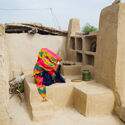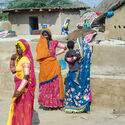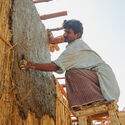Architecture as Activism: Yasmeen Lari’s Eco-Feminist Work

Yasmeen Lari’s Pakistani Chulah – an outdoor stove used by women in South Asia- is a powerful intervention that highlights the architect’s commitment to feminist and environmental activism. The project synchronically tackles issues of deforestation, pollution, and health hazards faced by women in rural areas. Her design is systemic, locally specific, and conscious of the needs of society’s most vulnerable – women and nature. Her vast body of humanitarian work elaborated on in Yasmeen Lari: Architecture for the Future, opens up a dialogue for viewing architecture through an eco-feminist lens.





The Pakistani Chulah
Culturally, South Asian women have been custodians of care – of their families, their communities, and the planet. Traditional methods of cooking – one such act of care – can expose women to burns, fires, and threatening respiratory issues when carried out using open fires in confined spaces. The open-flame, wood-burning floor stoves predominantly used in rural Pakistan also result in environmental hazards like air pollution and high fossil fuel consumption.
Related Article
Shaping History: The Impact of Women Architects in Post-Colonial South Asia

Using her design acumen and knowledge of local building technologies, Yasmeen Lari developed a smokeless, low-cost mud-and-lime-plaster stove that safeguards women and the environment from harm. A mudbrick platform elevates the stove, protecting the area from flooding and providing a more hygienic and ventilated workstation. The dignity of the women responsible for cooking rises symbolically too.
Lari’s stove is a well-rounded eco-friendly design. It uses half the amount of fuel usually required and can run on clean-burning agricultural waste like dung and sawdust bricks. Apart from a reduced carbon footprint, this alternative prioritizes women’s comfort by reducing their time spent sourcing logs from a dwindling supply.
The Pakistan Chulah was one part of what Lari has called the Barefoot Architecture Project. Local know-how and training allow women to build stoves using natural materials. Unlike contemporary alternatives, local materials like mud can be produced and processed by women without an income. The use of indigenous practices was crucial to the success of the project, empowering nonliterate women with the knowledge they already possess.

In the context of Muslim culture in Pakistan, the home is largely the center of women’s lives. Lari’s work acknowledges the separation of women from public life by designing essential infrastructure to support their social, emotional, and biological needs. Shelter, clean water, safe toilets, healthy cooking facilities, and community spaces outside the home are the essentials Lari has identified as central to architecture.
The Pakistani Chulah succeeds in reducing the isolation of women in the home by becoming a space for community and social interaction. In this case, Lari’s work challenges the idea of public space for Pakistani women while maintaining cultural notions. She has similarly designed spaces for women’s social needs in her residential projects Angoori Bagh Housing and Naval Housing.
Yasmeen Lari and Eco-Feminism

Among Lari’s social commitments is a focus on those whose needs have historically been silenced: women and nature. Her work can be labeled “ecofeminist” for concurrently addressing the needs of women and the planet. Ecofeminist analysis explores the parallels between women and nature in culture, economy, religion, politics, and iconography. Feminism and environmentalism might be combined to promote respect for women and the environment, motivated by the notion that the historical precedent of associating women with nature had led to the oppression of both.
A result of a gendered division of labor, women who are primarily occupied with caretaking and agriculture face the largest threats caused by environmental degradation. Women’s sole responsibility for children and elders, and as food providers put them on the frontline in times of climate-induced disasters. Since they majorly work at home and in the fields, Pakistani women are particularly endangered by floods and drought. While women would be responsible for setting up houses in emergency shelters, they are marginalized from disaster planning, reconstruction, and climate policy conversations.

Amidst the enormity of climate destruction in Pakistan, which ranks among the top ten climate-impacted countries, Lari’s work in relief architecture empowers the population to build their own flood-resistant and climate-friendly housing. Her approach builds on cost-effective and ecological local construction techniques by improving them structurally for flood and earthquake resistance. The architect has also facilitated conversations between women and aid organizations to vocalize the former’s needs.
Through Lari’s Heritage Foundation and Zero Carbon Cultural Centre, women are trained to make bricks, chulahs, and houses. The space is also used by women from neighboring villages to make eco-friendly ceramic tiles, which are later used in Lari’s projects. Making traditional craft techniques available to village women means investing in local and gender-responsive economies. The Pakistani architect’s humanitarian efforts supporting indigenous feminist knowledge enhance the social and economic resilience of women. Their new skills subsequently help regenerate their communities to facilitate care for the environment with eco-architecture and local materials.

Yasmeen Lari’s architecture is an act of care: for the planet and for the lives of Pakistani women. More than an architect, her work positions her as an activist at the intersection of feminism and environmentalism. She doesn’t identify as an eco-feminist architect, though. Lari aims to democratize architecture and encourage practitioners to solve pressing social issues with their design skills, regardless of the cause. By placing the daily experiences of women and their roles as guardians of nature at the center of her work, Lari sets a precedent from which both architects and activists can learn.
Related Article
Shaping History: The Impact of Women Architects in Post-Colonial South Asia


 العربية
العربية